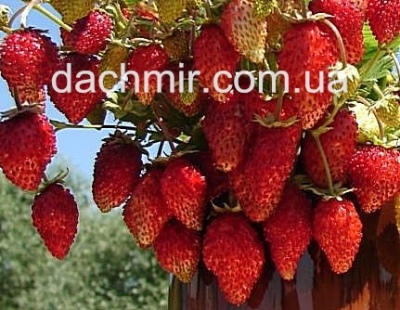
- Taste: dessert
- The size: small
- Weight: 4-6 gr
- Yield rate: high
- Yield: 1 kg per bush
- Repairability: Yes
- Ripening terms: mid-late
- Appointment: universal
- Description of the bush: short, hemispherical, compact
- Berry color: red
The Rügen repair strawberry is an early fruitful variety that bears fruit throughout the summer period until the first frost appears.
Description of the variety
The plant belongs to the group of mustacheless varieties bred by German breeders. As the strawberries develop, they form small bushes with medium-sized leaf plates.
Rügen strawberries are in demand among gardeners due to their resistance to frost and pests. An unpretentious plant can be planted in almost any soil. The bush will quickly take root and begin to produce crops.
Ripening terms
Rügen begins to bloom in late May in warm regions and early June in cooler areas. The fruiting period lasts from mid-June to the first frost.
Yield
The variety gives a bountiful harvest towards the middle of summer. In the active period of fruiting, up to 1 kg of berries can be harvested from the bush.
Berries and their taste
The strawberries have dense berries of a rich red color with yellow blotches, the weight of one fruit can reach 5 g. The aroma of the berries is pleasant, the taste gives off a slight sourness. The peculiarity of the variety is that the fruits of the bush are excellent for further processing after harvest. You can make from berries:
- jam;
- jam;
- compote;
- dessert.
Also, the fruits can be frozen to enjoy your favorite taste in winter.
Growing features
The variety is quite unpretentious. You can grow strawberry bushes both in sunny areas and in shaded areas. Gardeners consider a slope or area protected from the wind to be the best option for planting.
Unlike other varieties, Rügen is characterized by increased resistance to cold. When growing berries in the garden, you do not need to cover them during the frost period.




Site selection and soil preparation
When choosing a soil for planting strawberry sprouts, it is recommended to give preference to slightly acidic or neutral soils. If this is not possible, then you can grow a bush on any other land, the main thing is to fertilize it with the necessary amount of nutrients.
One of the features of Rügen is that the bush quickly draws out all the useful elements from the soil. Therefore, the plant needs to be transplanted to a new location every 2-3 years.

Pollination
In gardening conditions, insects are engaged in pollination, which wake up closer to spring. If the berry is grown at home, then you will need to take care of artificial pollination and highlighting the bush.
Top dressing
The soil in which the Rügen seedlings grow should be abundantly saturated with nutrients. During the season, it will be necessary to apply useful fertilizers several times so that the plant does not lack nutrition.
At the beginning of March, the first fertilizer mixtures need to be added to the ground: ammonium or potassium nitrate. Organic will also work. Before fertilizing the soil, it is recommended to carefully study the instructions so as not to harm the seedlings.
At the stage of ovary formation, it will be necessary to additionally add phosphorus or potash fertilizers to the soil, previously diluted with slurry. In autumn, to strengthen the roots of the bush, gardeners are advised to fertilize the ground with chicken droppings.

One of the important techniques in strawberry care is feeding. Regular fertilization guarantees a rich harvest. There are several different ways to feed strawberries, and each of them is designed for a specific period of plant development. During flowering, fruiting and after it, feeding should be different.
Frost resistance and the need for shelter
Preparing strawberries for the winter involves examining the bushes. The roots that have got out should be carefully covered with soil. In order for the plant to survive the cold better, you can cover the layer of earth near the strawberry with mulch, and the plant itself with agrofibre.

Diseases and pests
Rugen strawberries are highly immune. But in the process of active growth, seedlings can be affected by rot and spotting. To prevent the onset of the disease, it is worth spraying the cuts with a weakly concentrated azophos in the spring. In summer, for prevention purposes, it is advised to use "Abiga Peak".
Additional processing may be required at the ripening stage of the fruit. In this case, the leaves can be sprayed with Lepidocide. Finally, in the fall, you will need to reapply 1% Azophoska.

Strawberries are often subject to many dangerous diseases that can seriously undermine their condition. Among the most common are powdery mildew, gray mold, brown spot, anthracnose, and verticillosis. Before buying a variety, you need to inquire about its disease resistance.
Reproduction
The plant is propagated in different ways.The cultivation of the Rügen variety from seeds is especially popular. The process will take a lot of time and effort, but the result will exceed all expectations.
The German sweet strawberry variety is a great option for growing both in the garden and at home.



















































































